
The morpho butterflies comprise many species of Neotropical butterfly under the genus Morpho. This genus includes more than 29 accepted species and 147 accepted subspecies, found mostly in South America, Mexico, and Central America. Morpho wingspans range from 7.5 cm (3.0 in) for M. rhodopteron to 20 cm (7.9 in) for M. hecuba, the imposing sunset morpho. The name morpho, meaning "changed" or "modified", is also an epithet. Blue morphos are severely threatened by the deforestation of tropical forests and habitat fragmentation. Humans provide a direct threat to this genus because their beauty attracts artists and collectors from all over the globe who wish to capture and display them. Aside from humans, birds like the jacamar and flycatcher are the adult butterfly’s natural predators.

The owl butterflies are species of the genus Caligo and are known for their huge eyespots, which resemble owls' eyes. They are found in the rainforests and secondary forests of Mexico, Central and South America.
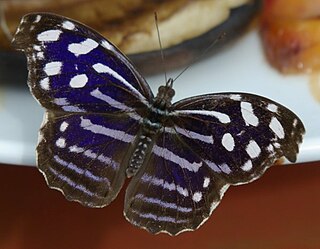
Biblidinae is a subfamily of nymphalid butterflies that includes the tropical brushfoots. This subfamily was sometimes merged within the Limenitidinae, but they are now recognized as quite distinct lineages. In older literature, this subfamily is sometimes called Eurytelinae.

Cyllopsis gemma, the gemmed satyr, is a species of butterfly of the family Nymphalidae. It is found in the southeastern United States and northeastern Mexico.

Adelpha is a genus of brush-footed butterflies found from the southern United States and Mexico to South America. They are commonly known as sisters, due to the white markings on their wings, which resemble a nun's habit. This genus is sometimes included with the admiral butterflies (Limenitis).

Callophrys sheridanii, the Sheridan's hairstreak and Sheridan's green hairstreak, is a butterfly in the family Lycaenidae. It is found in North America along the south coast of British Columbia and parts of Nevada, Arizona, Saskatchewan, North Dakota, and New Mexico. In 2009, this species was adopted as the U.S. state butterfly for Wyoming.

Eurema daira, the fairy yellow, barred yellow or barred sulphur, is a butterfly of the family Pieridae. The species was first described by Jean-Baptiste Godart in 1819. It is found from Argentina north to the southern United States. Strays can be found up to southern Arizona, South Dakota, southern Texas and even Washington, D.C.
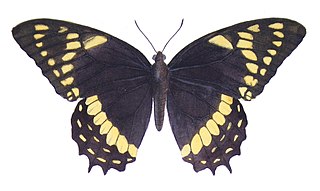
Papilio menatius is a butterfly of the family Papilionidae.

Mimoides phaon, the red-sided swallowtail or variable swallowtail, is a species of butterfly in the family Papilionidae. It is native to the Americas.

Marpesia is a butterfly genus in the family Nymphalidae. The species of this genus are found in the Neotropical and Nearctic realms.

Lycorea halia, the tropical milkweed butterfly, is a species of nymphalid butterfly in the Danainae subfamily. It is found from Peru to the Caribbean and Mexico. Strays can be found as far north as Texas. The habitat consists of rainforest.
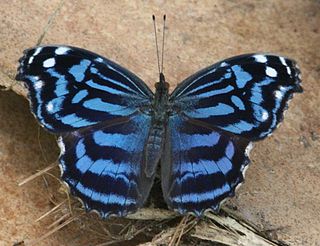
Myscelia is a genus of nymphalid butterflies found in southern North America, Central America and South America.
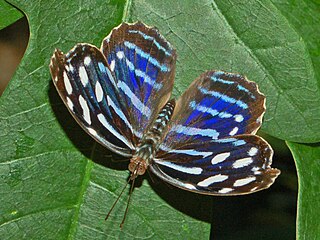
Myscelia cyaniris, the blue wave, blue-banded purplewing, tropical blue wave, whitened bluewing, or royal blue, is a butterfly of the family Nymphalidae.
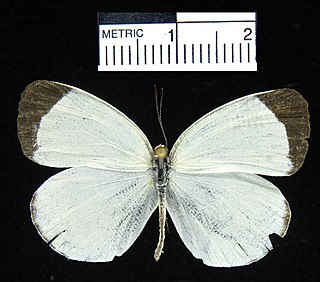
Eurema albula, the ghost yellow, is a butterfly in the family Pieridae. It is found from southern Texas south through the West Indies and mainland tropical Central and South America to Brazil. The habitat consists of tropical forests and second growth.

Eurema boisduvaliana, commonly known as Boisduval's yellow, is a butterfly in the family Pieridae. It is found from Costa Rica north to Mexico. Rare strays may be found in southern Florida, but it is a regular migrant to south-eastern Arizona, south-western New Mexico, and southern Texas. The habitat consists of subtropical forests and forest edges, scrubs, roadsides and pastures.
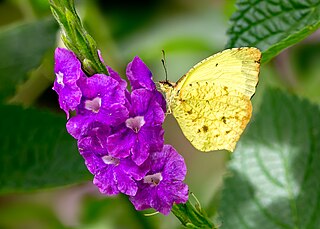
Eurema salome, the Salome yellow, is a butterfly in the family Pieridae. It is found from Peru northward through tropical America. It is an extremely rare migrant to the lower Rio Grande Valley in Texas. The habitat consists of forest openings and edges and roadcuts.

Milnesium tardigradum is a cosmopolitan species of tardigrade that can be found in a diverse range of environments. It has also been found in the sea around Antarctica. M. tardigradum was described by Louis Michel François Doyère in 1840. It contains unidentified osmolytes that could potentially provide important information in the process of cryptobiosis.

Myscelia cyananthe, the blackened bluewing, is a species of tropical brushfoot in the butterfly family Nymphalidae. It is found in North America.

Anaea are a genus of charaxine butterflies in the brush-footed butterfly family Nymphalidae. The butterflies are commonly known as leafwings. Members of the genus are found throughout the United States, Central America, and the Caribbean.























